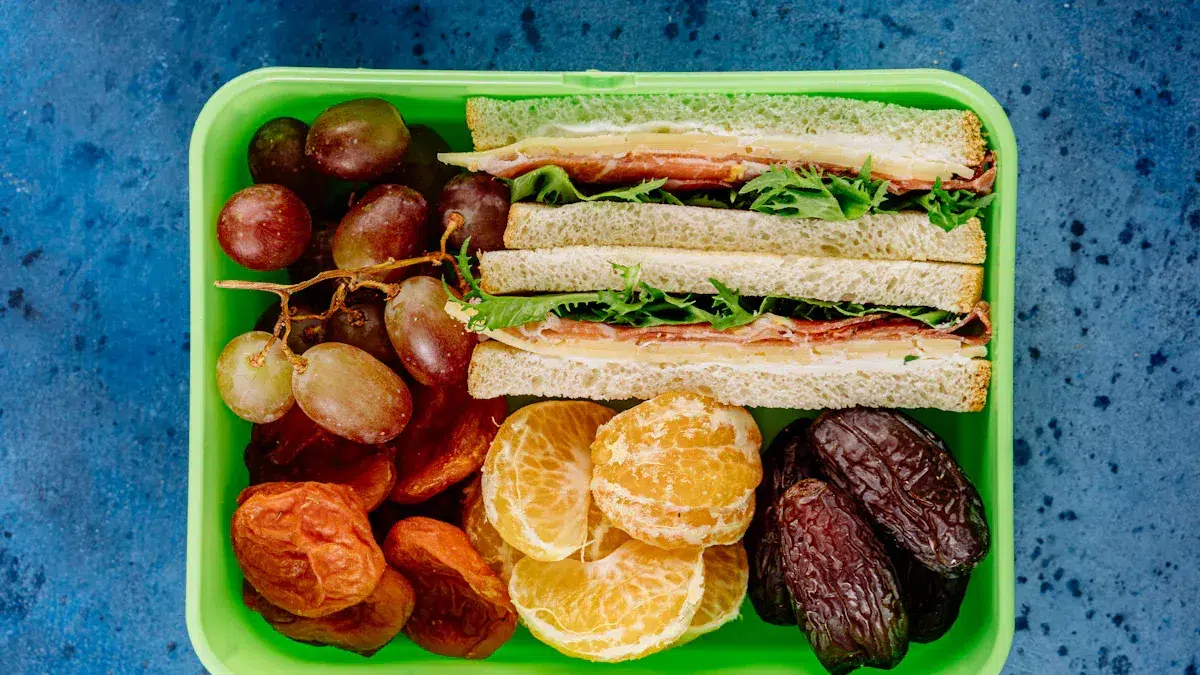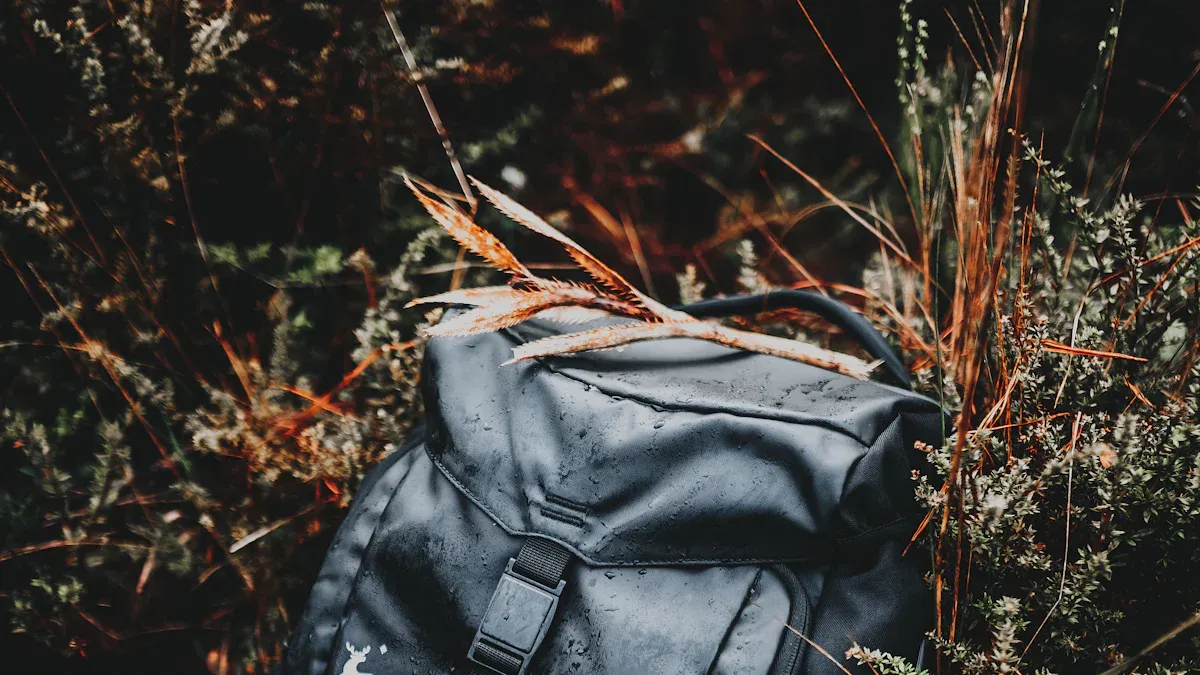
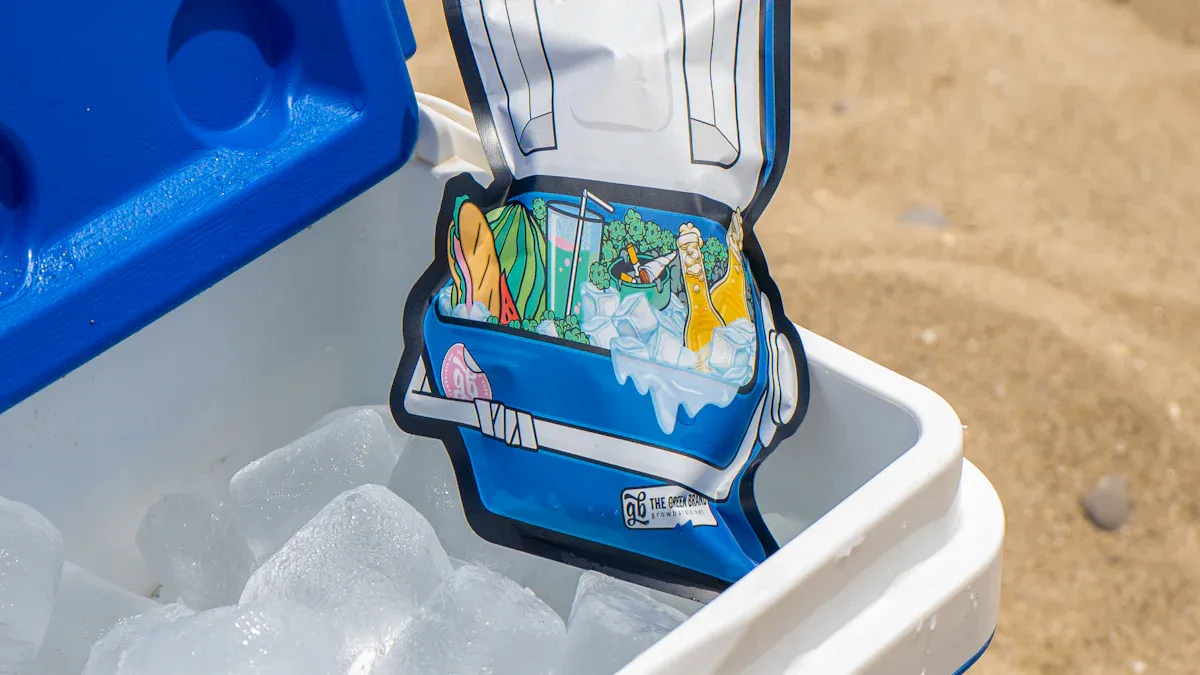
An insulated cooler box keeps your food and drinks cold by slowing the transfer of heat. The insulation inside the roto cooler acts as a powerful barrier. Advanced materials like open-cell microporous polyurethane panels can keep items cold nearly three times longer than standard insulation. You rely on ice or cold packs to absorb heat. Most of the cooling power comes from the ice melting; about 76.5% of the heat absorbed happens when ice turns to water.
| Heat Absorption Component | BTU Absorbed | % of Total Heat Absorbed |
|---|---|---|
| Specific Heat Capacity of Ice | 16 | 7.5% |
| Latent Heat of Fusion of Water | 144 | 76.5% |
| Specific Heat Capacity of Water | 28 | 15% |
KUER one of the leading cooler box manufacturers, our design ensure your cooler box performs at its best. If you wonder how does a cooler box work, the answer lies in the science of insulation and smart engineering.
How an Insulated Cooler Box Works
Heat Transfer Basics
When you place cold drinks or food inside a cool box, you want to keep them cold for as long as possible. To understand how an insulated cooler box works, you need to know how heat moves. Heat always flows from a warmer area to a cooler one. This happens because of three main processes: conduction, convection, and radiation.
- Conduction is when heat travels through solid materials. If you touch a metal spoon left in hot soup, your hand feels the heat because of conduction.
- Convection happens in liquids and gases. Warm air or water rises, and cooler air or water sinks, creating a flow that moves heat around.
- Radiation is when heat moves through space as waves, like the warmth you feel from the sun.
The first and second laws of thermodynamics explain these processes. The first law says energy cannot be created or destroyed, only changed from one form to another. The second law tells you that heat always moves from hot to cold. In a cooler box, this means heat from the outside air tries to get inside and warm up your cold items.
Fourier’s law describes how heat flows through materials. It says the rate of heat transfer depends on the material’s thermal conductivity, the area, and the temperature difference. Materials with high thermal conductivity, like metal, let heat pass through quickly. Materials with low thermal conductivity, like foam, slow down the heat flow.
Tip: The less heat that gets inside your cool box, the longer your food and drinks stay cold.
Insulation as a Barrier
Insulation is the secret weapon inside every insulated cooler box. It acts as a barrier that slows down the movement of heat from the outside to the inside. The better the insulation, the longer your cooler keeps things cold.
Manufacturers use different materials for insulation, such as expanded polystyrene (EPS), extruded polystyrene (XPS), and polyisocyanurate foam (PIR). Research shows that these materials have different thermal properties. For example, EPS and aluminum foil both provide strong insulation, but aluminum foil has the lowest heat transfer rate. When you combine aluminum foil with polyethylene, you can boost insulation performance by 46% compared to polyethylene alone.
| Material | Thickness (mm) | Thermal Heat Energy (Qx, ×10⁻⁴ J/s) | Performance Metrics |
|---|---|---|---|
| Aluminum Foil | 0.157 | 1.40 | Best insulation, lowest heat transfer |
| EPS | 18.543 | 1.77 | High insulation performance |
| ALF + EPE | N/A | 3.22 | Enhanced composite properties |
You should also know that insulation can lose its power if it gets wet or is stored poorly. Studies found that moisture can increase the thermal conductivity of insulation by up to 19% for some materials. This means more heat gets inside your cooler box, and your ice melts faster. Always store your cool box in a dry place to keep the insulation working well.
Some coolers use phase change materials (PCMs) like brine or ethylene glycol-water blends. These materials absorb and release heat at certain temperatures, helping to keep the inside of the box cold for longer. The choice and placement of these materials can make a big difference in how well your cooler box performs.
When you pick a cool box, look for thick, high-quality insulation. The right materials and design help block heat and keep your food and drinks cold, even on hot days.
Insulation in Cooler Boxes
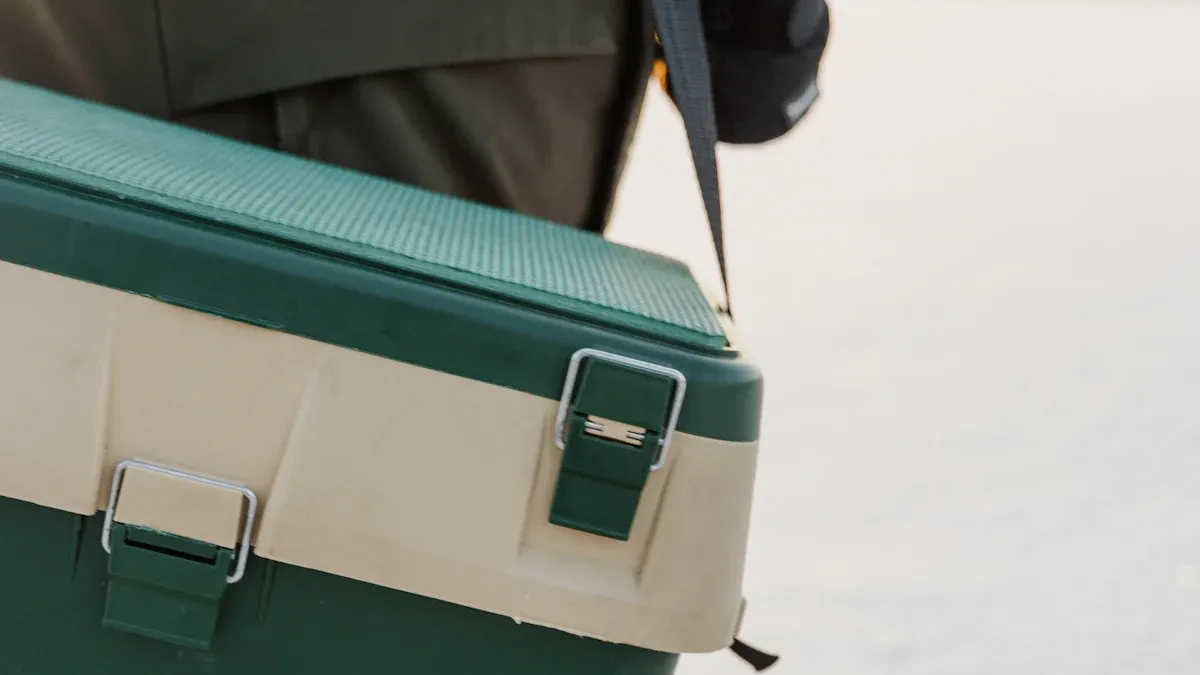
Materials Used
When you choose a cooler box, you want to know what makes it keep things cold for so long. The answer lies in the insulation materials inside the walls and lid. Manufacturers use different types of insulation to slow down heat transfer and keep your food and drinks safe.
The most common insulation materials in cooler boxes include expanded polystyrene (EPS), polyurethane foam, and phase change materials (PCM). EPS is lightweight and easy to shape, making it a popular choice for many coolers. Polyurethane foam offers better insulation performance because it has a lower thermal conductivity, which means it slows heat movement more effectively. Some advanced cooler boxes use PCM, which can absorb and release heat at certain temperatures, helping to keep the inside temperature stable for longer periods.
Testing and certification play a big role in making sure these materials work as promised. For example, companies use tools like the TCi Thermal Conductivity Analyzer to measure how well insulation materials block heat. These tests follow strict standards, such as ASTM C201 and NIST reference values, to ensure accuracy. Expanded polystyrene foam samples have shown results within 2.13% of NIST reference values, proving their reliability. Intertek and other labs also test insulation for thermal performance, using equipment like Guarded Hot Box and Heat Flow Meters. These certifications help you trust that your cooler box will perform as expected.
Researchers have also tested how insulation materials perform in real-world conditions. In one study, coolers were placed in a hot room for 10 days with ice inside. Temperature sensors tracked how long the coolers kept food below 40ºF (the safe limit for food) and 50ºF (the ideal drink temperature). The results showed that the type and quality of insulation directly affected how long the cooler stayed cold.
You can see from these facts that the choice of insulation material is not just about cost or weight. It is about how well the cooler box can protect your food and drinks from heat, even in tough conditions.
| Study / Author | Material / Configuration | Key Thermal Performance Metrics | Additional Notes |
|---|---|---|---|
| Sovetova et al. | Microencapsulated PCM layer in facade | Energy consumption reduction up to 34.26%; Thermal amplitude reduction 40.67%–59.79%; Indoor peak temperature reduction 0.2 °C to 4.3 °C; Ambient thermal load reduction ~38% | Numerical analysis in hot desert climate |
| Bahrar et al. | Textile-reinforced concrete panels with micro-encapsulated PCM | Lower thermal conductivity with increased PCM content; Peak internal surface temperature reduced by 1.7 °C | Experimental and numerical modeling |
| Li et al. | PCM-embedded walls in rural residences | Energy savings of 12.9%; Heating load decreased by 12.8% on south facade; Optimal PCM melting point 16 °C; Carbon footprint reduced by 52.7 kg/m² | EnergyPlus simulation and economic/environmental analysis |
| Liu et al. | Multi-layer glazing facade filled with PCM | PCM thickness critical: increased thickness lowers heat loss, increases time delay and internal surface temperature; Recommended max thickness 20 mm | Experimental validation for cold climates |
Note: The table above shows how different insulation materials and configurations can reduce energy use and keep temperatures lower, which is important for cooler boxes as well.
Importance of Thickness
The thickness of the insulation in your cooler box matters just as much as the material itself. A thicker layer of insulation creates a stronger barrier against heat, helping your cooler stay cold for longer. You can think of it like wearing a heavy winter coat instead of a thin jacket on a freezing day.
Studies show that insulation thickness has a direct impact on how well insulated a cooler box is. For example:
- Thermal conductivity values for insulation materials range from 0.005 W/m·K (for high-performance vacuum insulation panels) to 0.04 W/m·K (for rock wool). Lower values mean better insulation.
- In building science, walls with more insulation thickness have lower U-values, which means less heat passes through. For example, rock wool walls need 160 mm thickness to meet strict energy standards, while high-performance panels need only 20 mm for similar results.
- Life cycle cost analysis shows that there is an optimal insulation thickness. If you add too little, you lose cooling power. If you add too much, the cost goes up without much extra benefit. The best cooler boxes find the right balance.
Researchers have used advanced tools like spectrophotometers and finite element simulations to test how insulation thickness and material affect cooling. They found that higher solar reflectance and emissivity improve cooling efficiency. In one test, materials achieved up to a 6.7°C temperature reduction at zero solar irradiance, but performance dropped as sunlight increased. This means that both the thickness and the surface properties of the insulation matter.
You should also pay attention to how well the insulation fits inside the cooler box. If there are gaps or poor workmanship, heat can sneak in and reduce the cooling effect. One study found that air gaps between insulation and the cooler walls increased heat flow by up to five times, showing the importance of quality construction.
When you pick a cooler box, look for one with thick, high-quality insulation that fits tightly. This will help you keep your food and drinks cold, even on the hottest days.
Cooling Agents in Ice Cooler Boxes
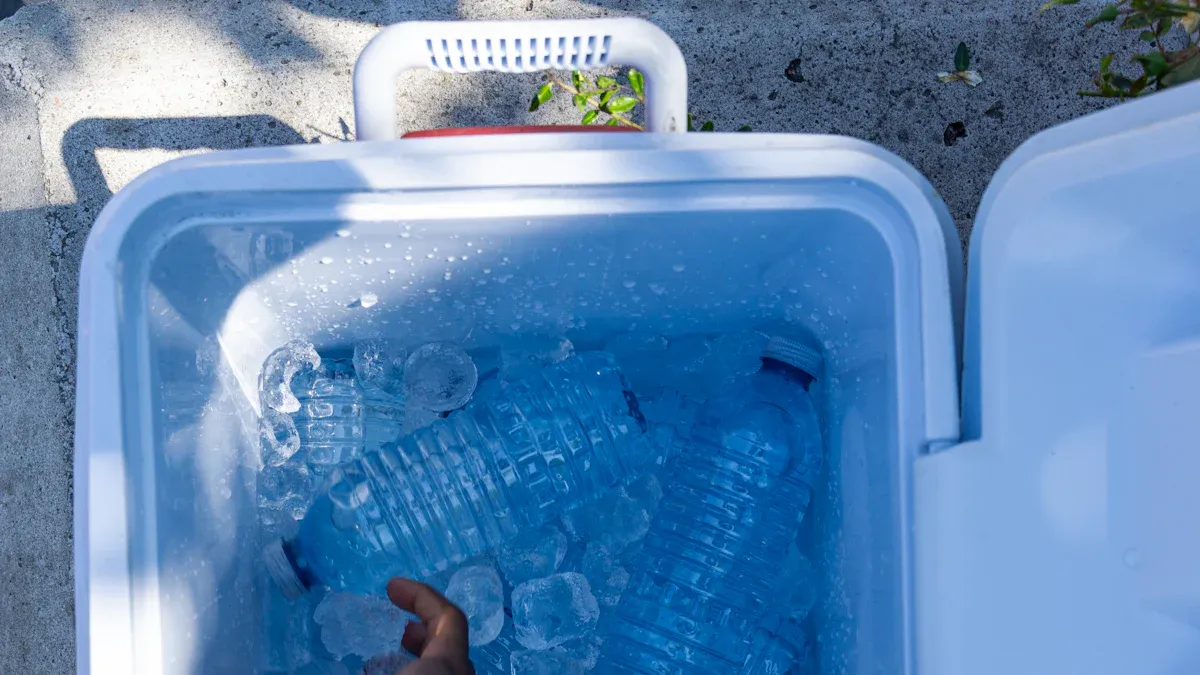
Ice Packs and Ice Cubes
You rely on cooling agents like ice packs and ice cubes to keep your ice cooler box cold for long periods. These agents absorb heat from inside the box, helping you protect perishable items such as food and medicine. Field studies show that both commercial cold packs and frozen water bottles can keep temperatures below 6°C for up to 27 hours, depending on the type of cooler and the amount of ice used. Rotomolded and polystyrene foam coolers hold cold temperatures longer than injection molded coolers. Large ice blocks, such as frozen water bottles, last longer than chipped ice or ice-water mixtures. You can use frozen water bottles as a cost-effective and reusable option. They are easy to clean and widely available, making them practical for many situations.
- Cold packs and frozen water bottles keep your ice cooler box cold for 11 to 27 hours.
- Each 0.45 kg frozen water bottle adds 7–8 hours of cold time in rotomolded and polystyrene foam coolers.
- Large ice blocks provide better ice retention property than small pieces of ice.
Using Cooling Agents Effectively
You can maximize the performance of your ice cooler box by following proven guidelines. Studies from Cambodia show that keeping water in the reservoir of an evaporative icebox significantly reduces the time that temperatures rise above 30°C. The table below highlights how much better a cooler box works with water compared to without:
| Location | Condition | Total Monitoring Hours | Hours > 30°C (%) | Statistical Significance (p-value) |
|---|---|---|---|---|
| Sampour Lo | CCB with water | 6,788 | 18 (0.3%) | 0.001 |
| Sampour Lo | CCB without water | 6,788 | 305 (4.5%) | 0.010 |
| Sampour Lo | Storage Room | 6,788 | 631 (9.3%) | N/A |
| Ankor Ban | CCB with water | 6,587 | 75 (1.1%) | 0.001 |
| Ankor Ban | CCB without water | 6,587 | 360 (5.4%) | 0.04 |
| Ankor Ban | Storage Room | 6,588 | 2,106 (32%) | N/A |
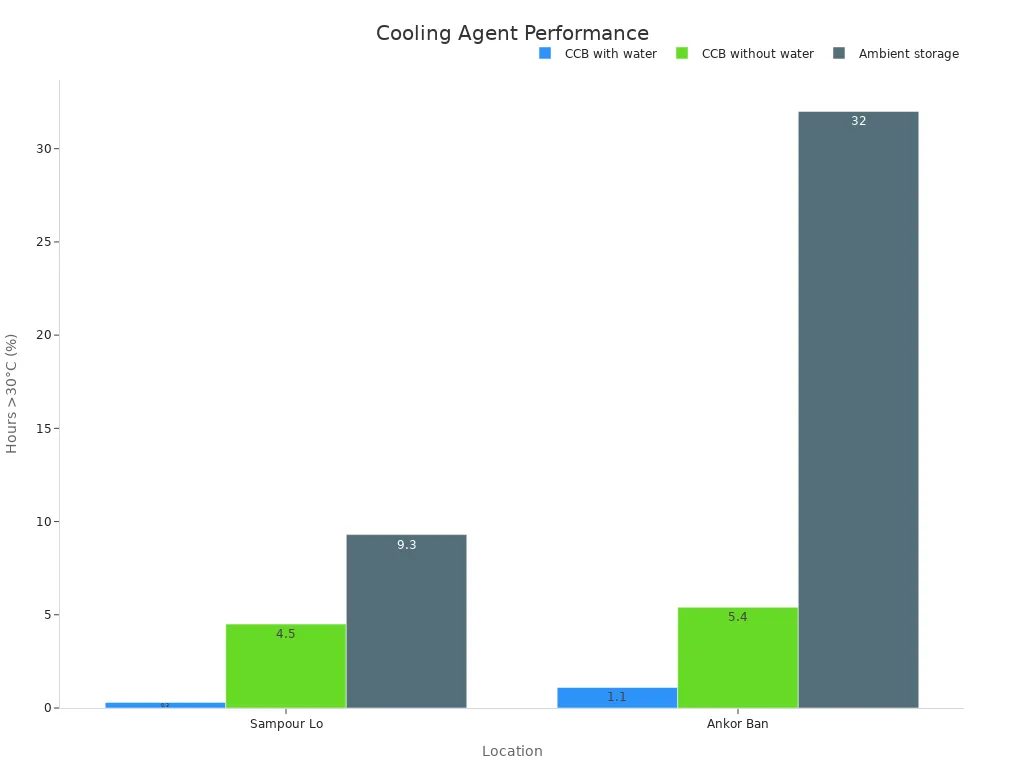
To get the best results from your ice cooler box, you should:
- Use large ice blocks or frozen water bottles for longer cooling.
- Fill empty spaces with ice packs to reduce air gaps.
- Keep the lid closed as much as possible.
- Pre-chill your icebox before loading it.
- Place perishable items near the cooling agents.
Tip: Always test your cooler box under real conditions to ensure it meets your needs.
Key Features of a Cooler Box
Lid Seals
You want your cool box to keep cold air inside and warm air out. The lid seal plays a big role in this. A tight lid seal stops air leaks, so your cooler holds its temperature longer. High-quality coolers use thick rubber gaskets or silicone seals around the lid. These seals press firmly when you close the lid, making it hard for heat to sneak in. If you open the lid often, you let warm air inside. Try to open your cool box only when you need something. This simple habit helps your food and drinks stay cold.
Design and Construction
The way a cool box is built affects how well it works. KUER uses advanced methods like rotomolding and blow molding to make strong, durable coolers. These techniques create thick, even walls that hold insulation tightly. Quality control checks make sure every cooler meets high standards. KUER’s R&D team designs cool boxes with features that boost cooling performance, like sturdy hinges and reinforced corners.
Shape and material choices also matter. For example, a study compared cuboid and cylindrical coolers with polyurethane insulation and phase change material plates. The cylindrical design kept the inside temperature 4.03% lower after 17 hours at 45°C. It also had 8.7% higher cooling efficiency and lasted 20.4% longer at 30°C. This shows that both the shape and the way you place cooling materials can make a big difference.
| Feature | Cuboid Box | Cylindrical Box |
|---|---|---|
| Insulation Material | Polyurethane (all sides) | Polyurethane (outer) |
| PCM Placement | Five sides | Inside the box |
| Cooling Performance | Baseline | 4.03% lower temp |
| Cooling Efficiency | Baseline | 8.7% higher |
| Cooling Duration | Baseline | 20.4% longer |
Best Practices
You can get the most from your cool box by following a few simple tips:
- Pre-chill your cooler before you pack it.
- Fill empty spaces with ice packs or frozen water bottles.
- Keep the lid closed as much as possible.
- Store your cool box in the shade.
Tip: Always check that the lid seal is clean and free from damage. A good seal keeps your cooler working at its best.
Types and Uses of Cooler Boxes
Hard-Sided vs. Soft-Sided
You can choose between hard-sided and soft-sided coolers based on your needs. Hard-sided coolers use strong plastics or metals. These coolers offer high durability and keep things cold for a long time. You might use them for camping, fishing, or long road trips. They can hold a lot and protect your food from bumps and drops. Soft-sided coolers use fabric like polyester or nylon. They are lighter and easier to carry. You may pick a soft-sided cooler for a picnic, a short hike, or a day at the park.
Here is a table to help you compare:
| Feature / Aspect | Hard-sided Coolers | Soft-sided Coolers |
|---|---|---|
| Material | High-quality plastics or metals | Fabric materials like polyester or nylon |
| Durability | High durability, robust protection | Less durable, flexible |
| Insulation Performance | Superior insulation, long-term temperature retention | Moderate insulation, suitable for short-term use |
| Portability | Heavier, less portable | Lightweight, highly portable |
| Typical Applications | Camping, fishing, long trips | Picnics, short hikes, day trips |
| Capacity Range | Larger capacities (51-100+ quarts) | Smaller capacities (up to 20 quarts) |
| Suitability by Activity | Long-term cooling, durability | Convenience, ease of transport |
Consumer tests show that hard-sided coolers keep ice for 2 to 10 days. Soft-sided coolers, like the Yeti Hopper Flip 18, can keep ice below 51°F for up to 40 hours. Hard-sided coolers are more durable, but some soft-sided models handle drops well. You should think about how long you need to keep things cold and how much you want to carry.
Specialty and Electric Coolers
You can also find specialty coolers for unique needs. Electric coolers use thermoelectric technology to keep food and drinks cold without ice. These coolers work well in cars, trucks, and electric vehicles. They use energy from batteries or the vehicle itself. Electric coolers save energy, especially when they use waste heat recovery systems. Some models can reduce energy use by up to 30% in tough conditions. However, they may lower your vehicle’s range if you use them for a long time.
Other specialty coolers include models with wheels, backpack straps, or extra compartments. These features make it easier for you to carry your portable cooler box on different adventures. KUER offers a wide range of insulated coolers, from hard-sided to soft-sided and electric models. Their factories use advanced rotomolding and blow molding to create coolers for camping, travel, and outdoor work. You can buy an ice cooler box that fits your needs, whether you want long-lasting cold or easy transport.
Tip: Match your cooler to your activity. For long trips, pick a hard-sided cooler. For short outings, a soft-sided or electric cooler may work best.
You get the best results from an insulated cooler box when insulation and cooling agents work together. Studies show that combining ice and phase change materials with advanced insulation can improve cooling time by up to 38.66%.
| Parameter | Configuration | Cooling Time Improvement |
|---|---|---|
| PU Insulation | Ice + PCM | +20.60% |
| Vacuum Insulated Board | Ice + PCM | +38.66% |
KUER’s strong manufacturing and design skills help you keep perishable items safe and fresh. When you use an ice cooler box, follow best practices for keeping perishable items fresh and enjoy reliable performance every time.
FAQ
How long can a cooler box keep items cold?
You can keep items cold for 1 to 10 days, depending on insulation, ice amount, and outside temperature. Hard-sided coolers with thick insulation last longer. For example, some rotomolded coolers keep ice for up to 7 days in controlled tests.
What is the best way to pack a cooler box?
You should pre-chill your cooler, use large ice blocks, and fill empty spaces with cold packs. Place perishable items near the ice. Keep the lid closed as much as possible. This method helps you keep food safe and cold for longer.
Can I use dry ice in my cooler box?
You can use dry ice in many hard-sided coolers. Dry ice keeps items much colder than regular ice. Always wear gloves when handling dry ice. Make sure your cooler has a vent for gas release. Never use dry ice in soft-sided coolers.
How do I clean and store my cooler box?
You should wash your cooler with mild soap and warm water after each use. Dry it completely before storing. Store your cooler in a dry, cool place. This helps prevent mold and keeps the insulation working well.

